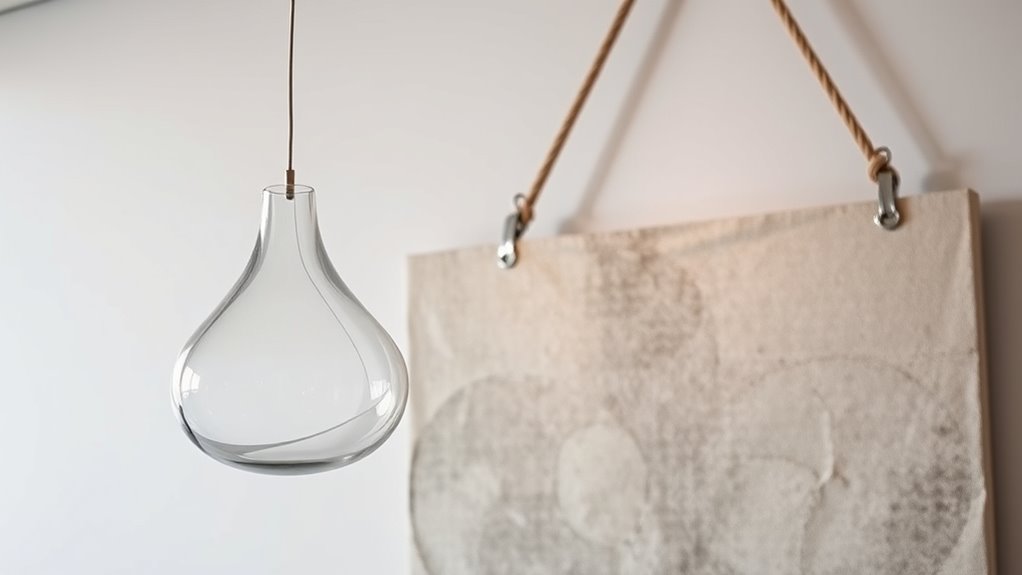Choose wire hanging for lightweight items or when you want a sleek, minimalist look that appears floating. It’s flexible and easy to fine-tune, perfect for small art or decorations. Opt for two-point hanging when you’re dealing with larger, heavier pieces that need extra stability and a formal appearance. This method keeps items secure and sway-free. To decide which fits your project best and discover more about their uses, keep exploring the details below.
Key Takeaways
- Choose wire hanging for lightweight artworks needing a minimal, floating appearance with easy post-installation adjustments.
- Opt for two-point hanging for larger, heavier items requiring maximum stability and a formal, structured look.
- Wire hanging offers flexibility on uneven walls and fine-tuning, ideal for casual or contemporary displays.
- Two-point hanging provides secure support, ideal for valuable or sway-prone pieces demanding long-term stability.
- Consider aesthetic style: wire for sleek, modern visuals; two-point for traditional, structured presentations.

When choosing how to hang your lights or artwork, understanding the differences between wire hanging and two-point hanging is essential. These methods impact not only how securely your pieces are mounted but also how they look and how easy they are to install. Your decision should consider the installation methods you prefer and the aesthetic considerations that best suit your space. Wire hanging involves suspending your piece from a single wire, usually attached at two points, which allows for a clean, minimal look. It’s often used for lightweight artworks or decorative lighting, where a nearly invisible support enhances the visual appeal. The installation method here typically involves attaching hooks or eyelets to the top of the artwork or fixture and threading a wire between them. Adjusting the wire’s tension can help level the piece, making it a flexible and straightforward option. It’s particularly suitable if you want a sleek, floating appearance or if the wall surface is uneven, since the wire can be fine-tuned for perfect alignment. Additionally, wire hanging offers adjustability in tension, allowing you to easily correct the positioning after installation.
In contrast, two-point hanging uses two separate points of support, which are usually attached to the top corners of the object. This method offers a more stable installation, especially for heavier or larger items, since the weight is evenly distributed across both points. The installation involves securing hooks into the wall at appropriate distances apart and attaching the artwork or fixture directly to these hooks. From an aesthetic standpoint, two-point hanging provides a more structured, traditional look. It’s ideal if you want your piece to hang flat against the wall without any sway or movement, which can be especially important for precision displays or valuable artwork. The two-point method tends to be more secure as well, reducing the risk of shifting or falling.
When deciding between the two, think about the weight and size of your piece, along with your aesthetic goals. Wire hanging is often preferred for lightweight, contemporary displays where minimal support is desired. Two-point hanging works better for larger, heavier items or those that require a more formal presentation. Both methods have their installation methods that influence ease and longevity—wire hanging may require more fine-tuning of tension, while two-point hanging emphasizes secure anchoring. Ultimately, your choice comes down to balancing the aesthetic considerations you aim for with the practical needs of installation and stability. Understanding these differences will help you achieve a professional, polished look that complements your space perfectly.
Frequently Asked Questions
Can Wire Hanging Support Heavier Artworks Than Two-Point Systems?
Wire hanging can support heavier artworks than two-point systems if it’s made from high-strength material and has a higher weight capacity. You should consider wire’s material compatibility and verify it’s rated for the artwork’s weight. Two-point systems often distribute weight more evenly but might have lower weight capacities. Always check the weight limits and use appropriate hardware to prevent accidents or damage.
Which Hanging Method Is More Secure for Outdoor Displays?
For outdoor displays, two-point hanging offers better security considerations, reducing the risk of the artwork falling due to wind or movement. It’s more stable and provides even weight distribution. Additionally, choose a system with weather resistance features like stainless steel or coated hardware. Wire hanging can be less secure outdoors, especially in windy conditions, making two-point systems the better option for ensuring your artwork stays safe and secure outside.
Are There Aesthetic Differences Between Wire and Two-Point Hanging?
You’ll notice aesthetic differences between wire and two-point hanging that impact your display’s visual impact and design flexibility. Wire offers a sleek, minimalist look, creating a floating effect that highlights your artwork. Two-point hanging provides a balanced, clean appearance, ideal for a polished presentation. Remarkably, 78% of viewers say the right hanging method enhances the overall visual appeal, making your display more engaging and professional.
How Do Installation Times Compare for Each Method?
You’ll find that wire hanging generally offers quicker setup speed and better installation efficiency, especially for lightweight fixtures, since it’s easier to adjust and secure. Two-point hanging may take a bit longer because it requires precise positioning and additional hardware for stability. If you want a faster, more streamlined installation process, wire hanging is often the better choice. However, for more stability, two-point hanging might be worth the extra time.
What Are the Cost Differences Between Wire and Two-Point Hanging?
Imagine choosing between a simple rope or a sturdy chain; your decision impacts your wallet. With wire hanging, you’ll find lower material expenses, making it more budget-friendly. Two-point hanging often costs more due to increased material and labor. The cost comparison favors wire for savings, but consider your project’s weight and stability needs. Balancing these factors helps you pick the most economical and effective hanging method.
Conclusion
Ultimately, choosing between wire and two-point hanging is like selecting the right thread for your tapestry. Wire offers strength and flexibility, symbolizing resilience in your design. Two-point hanging represents balance and stability, like the steady anchor in your creative journey. Trust your vision and the story you want your display to tell. When you pick the right method, your art becomes a beacon—shining brightly, perfectly framed, and ready to inspire everyone who gazes upon it.









